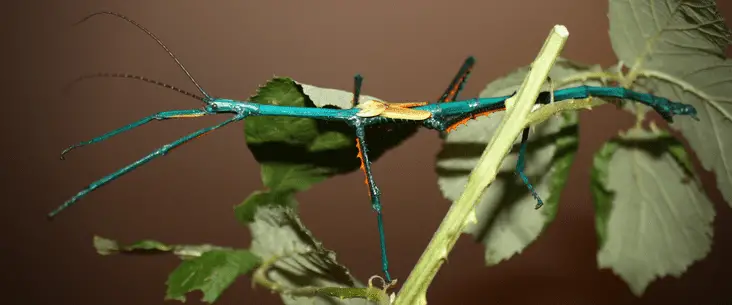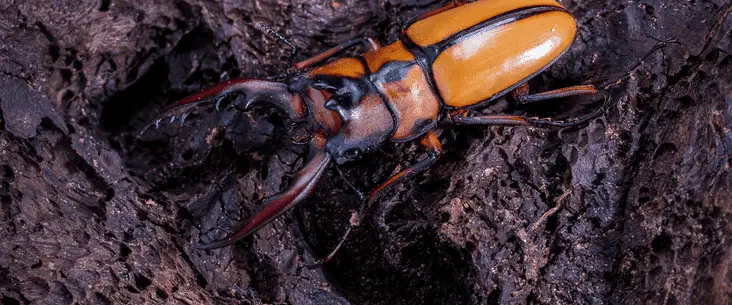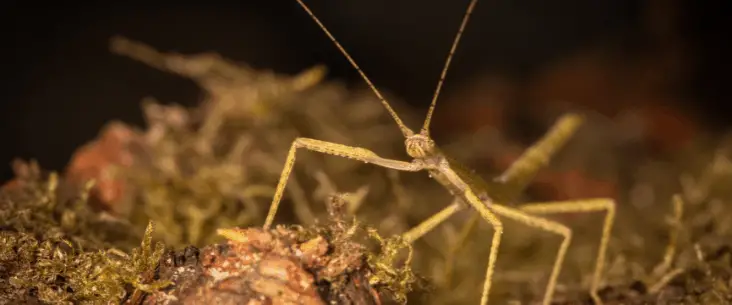Giant African millipedes (Archispirostreptus gigas) are one of the most popular millipede species and are widely available to keep as pets. In fact, they are the largest species of millipedes in the world, reaching a whopping 30 cm when they are adults. And although they are quite easy to keep as pets, these beautiful creatures are often misunderstood and there are not many guides that completely cover how to keep and care for them. In short:
Giant African millipedes are large beginner millipedes that should be housed in an enclosure of at least 90cm x 30cm x 30cm with a tropical temperature of 24°C to 29°C and a moderate humidity of around 70%. A good layer of quality substrate is essential for them to stay healthy and also to successful breeding with them.
However, there is so much to learn and understand before keeping this millipede species. Hopefully, this guide will provide you with all the information and answers to your questions, so you can keep these fascinating animals happy and you can really enjoy them as well.
We partner with companies that offer products that we think are great for you to use, and that can help you achieve your goals. If you purchase through our partner links, we get paid for the referral at no additional cost to you! Please read our disclaimer for more info.
About the giant African millipede

Appearance
The giant African millipede has a glossy brown/black colour and with a size of 19 cm up to 28 cm (7.5″-11″), it is a real giant. There are some individuals known to grow up to a staggering 33 cm (13″). Females are generally larger than males and they can differ 5 to 10 cm in adult body length. When becoming adults, they can develop some lighter coffee brown up to almost yellow bands on each segment.
It is the largest millipede species in the world. The body exists of many body segments and each body segment has 2 pairs of legs. When fully grown it has around 50 to 60 body segments and has approximately 256 legs in total (and not 1000 as the species name suggests). It has a tubular or trunk body shape and on its head are two antennae attached and they have two simple eyes called “ocelli”. When a new baby millipede hatch they are small and have fewer segments. With each moult, new segments are attached to its body and make them longer and longer (and they will get more legs each time).
On the 7th body segment is the sexual apparatus located. Although you can’t see that with females, with males the 7th segment is missing one pair of legs. There are the gonopods located, which are two small stumps. When not visible, there is a gap between the legs.
Behaviour, temperament and handling
These millipedes are slow-moving and quite docile. They will normally rest a lot of time onto or below in the substrate. They are not very active compared to other species of millipedes. Especially when they are not adult-sized you will see them hide a lot. They tend to be more active during the night, although in the captive environment adults will also walk during the day in search of food.
Millipedes are calm and can live perfectly with roommates (if enough space) or with other millipede species (or even other insect species). Although calm and quite harmless to humans, they can get frightened quite easily. As a defence, they curl up into a spiral and when they really don’t like it they secrete an irritating liquid out of body pores.
Now, they can be handled when careful and some millipedes are really got used to walking on peoples hands. It is best to let them walk or nudge them slightly onto your hand, instead of picking them up (also, they try to grab themselves on anything). When you do it carefully and let the millipede decide if it wants to, they can perfectly be handled.
All in all, these millipedes make great pets and even with their size, they are one of the best beginner millipede species if you have enough space. They are very popular because of their calm temperament and slow-moving behaviour, and of course their impressive body size.
Housing requirements for giant African millipedes
We start this care guide with housing. A good home is fundamental for your millipedes to thrive. Although millipedes generally don’t require that much space, they need enough surface and properly sized housing. And there are some important features you should consider to create the perfect home for them. All this is discussed in this section.
Type and size of the millipede enclosure
Giant African millipedes can best be housed in a terrarium, repurposed aquarium or plastic container. I prefer to have a terrarium because it has all the essential features that are perfect for keeping millipedes. However, terrariums are generally more expensive than a glass aquarium tank or plastic container.
Terrariums and glass tanks make it more enjoyable to observe your animals and have higher visibility onto your animals. Plastic bins generally have lesser visibility, and even when they are transparent they are less attractive to look at your animals. However, the new market of acrylic tanks is much better when it comes to visibility.
Good ventilation is key to keep your millipedes healthy and happy. In the case of a repurposed aquarium or plastic container, you’ll need to make some adjustments to the lid so there is enough ventilation. Although these giant millipedes live on the surface floor, they are very well able to climb and a lid is highly recommended to prevent any escape. When a lid is provided you can easy drill small holes in it or cut out big holes and cover it with metal wired mesh.

With millipedes, floor space is more important than the height of a terrarium (although some millipede species like to climb though). The general rule is that your choose a terrarium that is three times the adult body length in width, and one time the adult body length in depth and height.
For a couple of these giant black millipedes, the size of the enclosure should at least be 90 cm x 30 cm x 30cm (33″x11″11″). Because these millipedes can be really big, you also need a rather large space to keep them in. But, with this terrarium size, you can easily keep 6 animals. If you want much more animals, you should even look at a larger tank. Please respect these enclosure dimensions. Millipedes in the small enclosure will be very unhappy, it affects their longevity (stressful animals are more sceptical to diseases) and breeding results.
For those cases especially, but also in general, you could also build your own terrarium tank. If you build it out of plastic sheets and clear acrylic plates you could build a tank that has the size needed and desired. However, keep in mind that you make enough ventilation for these animals and don’t forget easy access to the enclosure. The use of wood is not suitable for building your own terrarium because of the high humidity needed in the enclosure. Wood and a lot of dampness do not work really well.
You’ll also see a lot of netting cages for insects. Although beautiful for many species, these are not suitable for your millipedes. These millipedes need a good layer of substrate and keep enough humidity. That is hard to provide with this type of enclosure.
Terrariums that are suitable for giant African millipedes
The following terrariums are great tanks for keeping giant African millipedes. They have all the features you need and provide great access to the enclosure to do maintenance and providing good care for them. Go check them out on Amazon.
Essential features of the millipede enclosure
It does not matter which type of enclosure you choose, as long as it has some essential features to are key for keeping your millipedes healthy. So always check if your enclosure has these features or add/provide these features.
- Ventilation — We already mentioned it a couple of times, but it is really important to have enough ventilation for your giant black millipedes. Without enough ventilation, the air becomes stagnant and substrate gets soaky and starts to mould. Terrariums generally have enough ventilation built-in, but with aquarium tanks and plastic containers you should make enough holes for ventilation yourself.
- Waterproof bottom — As we will cover in the next section, these millipedes need a good layer of substrate. This substrate contain water and in some cases is bio active (with springtails). Therefore it is important that your terrarium can hold at least 10 cm (4″) of substrate without water, or even worse the substrate, running out of the enclosure.
- A lid — Now this millipede species does not climb that much and live most of the time at the substrate floor. However, they are quite able to climb and without a lid the millipedes will climb out in no time (even with a overhang).
- Easy access — This is more for convience, but easy access make it much more enjoyable for you to keep and care for your giant millipedes. Large hinged doors or a removable lid provide easy access for maintenance and decorating.
The substrate for giant African Millipedes
Although the right enclosure is one thing, the substrate is evenly important for millipedes. To place it in perspective: The substrate is life for millipedes. Without a good quality substrate, millipedes will reduce longevity and makes them more stressful, which may result in illness and they will be more difficult to handle.
The substrate exists of two parts: A base component (creating volume) and a food component (which makes it of high quality). The substrate for this species should be around 10 cm (4″) thick, but for breeding, you should even increase it to 12 or even 15 cm (4.7″-6″). Let’s discuss both components in more detail.
- The base component is primarily to do two things — create volume so you have enough substrate to fill the enclosure, two isolate so it keeps the enclosure on the right temperature, and to keep the right humidity. The best product to use as a base component is coconut fibre. This product is clean, lightweight, has good absorbance capacity, has a consistent structure, is cheap and is loved by millipedes. Coconut fibre is also called coco fibre, eco earth, coir fibre and humus bricks (check out my favorite coconut fibre brand on Amazon). Other products that can be used as a base component is topsoil, potting soil or organic compost. However, in my experience and that of many keepers, coconut fibre works best as a base component.
- The food component is, as the name suggest, there to provide enough nutrition to your millipedes. When you keep millipedes with a top quality substrate, you don’t need to feed them. Millipedes are detritivores, which means that they primarily eat decaying organic matter. These giant millipedes live on the forest floor which is covered with fallen leaves, rotten wood and decating substrate. For millipedes this is the food they eat. To create a good quality substrate you should add decaying leaves and decaying wood (flakes) to your substrate. You could also add sawdust of untreatened wood. Use wood and leaves from hardwood tree species such as oak, beech, birch, and hazel.
There is much to learn about the substrate for millipedes. I have written a complete guide on the substrate for millipedes and I highly encourage you to read it to have a better understanding of what good substrate is and how you can make your own substrate.
Decorating the enclosure
Giant African millipedes like to hide during the day, so you should provide so shelters. What really works well is to add some bark and cover the substrate floor with a good layer of leaves. Although it creates more space for your millipedes to hide, practice learns that when a millipede feels comfortable they will show themselves more often, walking on the substrate floor.
Although this species is a ground-dwelling millipede, they still like to stretch their legs from time to time. Add some climbing structure in the enclosure for them to climb on and bask below the light. They will appreciate it. But make sure the branches are stable and secure in the enclosure so that when they are digging beneath it the won’t branch won’t fall over.
You could even decorate your enclosure further with some artificial or live plants, wood pieces and sphagnum moss (this last is very good for keeping a humid environment). Although the animals will like it, it is also more enjoyable for you to see your animals walking in a small mini-ecosystem.
Try to avoid large and heavy objects like rocks and pebbles. These millipedes will dig tunnels below it and although this is not a problem for adults, smaller millipedes can be crushed under the weight when the heavy rocks start to sink.
Environmental conditions to keep your millipedes healthy
Your living room — or any other room for that matter — generally don’t have the climate that is required to keep this species. In the wild, these millipedes are commonly found in areas of dry savanna in Eastern and Southern Africa. So you need to recreate the natural environmental conditions in your enclosure. In this section, we discuss how.
Temperature and heating
Giant African millipedes thrive within the temperature range of 24°C and 29°C (75°F-84°F). So they need to be kept warmer than average room temperature. That means additional heating is necessary to create the perfect temperature for them. I have to mention, they can survive on lower temperatures and a normal drop in temperature during the night is even advisable. However, they won’t grow that well and probably don’t breed with continuous lower temperatures around 18°C to 20°C (64°F-68°F). Try to avoid temperatures higher than 30°C (86°F). It will quickly dry out the substrate and makes it too warm for this species.
Heating is quite easy, especially with lower terrariums. Just place some simple light bulbs of around 25W to 35W above the enclosure will provide enough heat. You could also use a heating pad, but don’t place it under your terrarium for two reasons: first, it dries out your substrate much quicker and secondly, when millipedes look for cooler places they start to dig. But when placed under the terrarium the lower they come the warmer they get.
A good practice is to use both heating methods. The light bulb to warm during the day, and a backup heating pad connected on a thermostat so it won’t cool off too much during the night (or when the ambient temperature is too low for the light bulbs to heat the enclosure).
Never place heating elements in the enclosure itself. Millipedes can be drawn towards the heat and burn themselves on the hot lamps or heating pad (although heating pads are generally safe on that matter).
Lighting and lightcycle
Although giant African millipedes are more active during nighttime, that does not mean they don’t need any light. In fact, they benefit from a normal day/night cycle. Now with the use of light bulbs as a heating source, you can easily create a normal 12h/12h light cycle. Light is often a misunderstood factor for natural biorhythms, which are just as important for these bugs.
Don’t use direct sunlight as a source for the light cycle. Direct sunlight can heat up the enclosure up to temperatures lethal for your millipedes. Indirect sunlight is completely fine, but keep an eye on the temperature of the enclosure.
As far as we know giant millipedes don’t require UVB light. It is thought that because they are most active when the sun is down and live on the forest floor oftentimes beneath the leaf litter, they don’t get much — if not any — sunlight on its body. However, there is no conclusive research evidence for this hypothesis.
Humidity and spraying
These millipedes need a moderately humid environment, which means that you should keep the humidity around 60% to 80%. They also need a damp substrate to successfully moult. When they need to moult they dig in the damp substrate to release their old exoskeleton.
To dampen the substrate you could use a hand sprayer to mist the substrate frequently. Adding sphagnum moss and leaf litter increase the humid capacity of the enclosure. After spraying let the top of the substrate dry first before you spray water again, otherwise, your substrate is getting too wet. Always avoid a soaking substrate. It is not healthy for your millipedes, they also don’t like it and it is a breeding ground for bacteria and mould.
A damp substrate is also essential for the survival of young millipedes and eggs. When you let the substrate dry out completely will lower their survivability.
Millipedes don’t need a water bowl. Just like any millipede, these giant African millipedes will get enough water from water droplets of the spraying, feeding on decaying matter and the supplemental food sources (more on that in the next section).
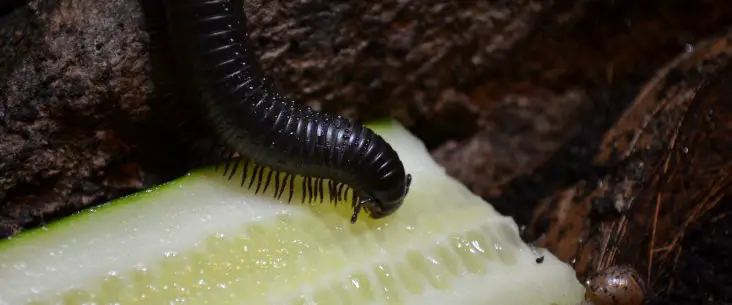
Feeding giant African millipedes
We already discussed the food substrate. When you have a high-quality substrate, these millipedes can solely survive on the substrate’s food component alone. The substrate is the most important part to keep a healthy millipede.
But, it is good practice to feed them supplemental food items as well for additional nutrients (minerals and vitamins). And, it is also much fun to see them munch on the food you provided, curling their antennae backwards and seeing them enjoy.
They also tend to grow faster and breed better when you feed them supplemental foods. Now, what is good supplemental foods for millipedes?
Supplemental food items
Products that are safe to feed and are liked by the millipedes include:
Fruits
- Apple
- Pear
- Organe
- Pumpkin
- Watermelon
- Cantaloupe
- Kiwi
Vegetables
- Cucumber
- Tomato
- Endive
- Chicory
- Celery
- Carrots
- Sweet potato
Pellets
- Dog pellets
- Cat pellets
- Fish pellets
- Fish flakes
Powdered food
- Calcium powder
- Powdered milk
- Baby powder formula
- Sepia (cruched)
Not all individuals like the same products. Some products tend to be better accepted than others. The products that I mention above are food sources that I experienced to be accepted by this species, safe to feed and are generally liked. However, you can feed other fruits and vegetables as well. It is best to use organic products only and wash all products thoroughly before feeding them.
Feeding method, amount and frequency
I like to place almost all food sources directly on the substrate. There is no need to place fruits, vegetables, leaves and flake soil in a food bowl. Especially when breeding, smaller millipedes are not able or will not climb into the food bowl and miss out on these foods. When placed directly on the substrate they can reach from below and munch on it without leaving the safety of the substrate. With multiple millipedes and also young millipedes try to feed throughout the whole enclosure so they don’t have to travel a too great distance. Normally smaller millipedes will stay in the same place where they know it is safe, and most likely will not travel to the other side of the enclosure for the food.
Although most foods can be directly placed or sprinkled onto the substrate, I prefer to feed pelleted food in a food bowl, and well for two reasons: One is when you spray the enclosure, water will remain in the food bowl and soaking the pellets and make them easier to eat for your millipedes. Secondly, it is much easier to clean and refresh the pellet food. Your millipedes probably try to drag the pellets into the substrate, but when left uneaten you can’t find it and throw it away. And wet pellets are a breeding ground for mould and bacteria, so it is best to throw them away at least after 48 hours.
How much food you should feed depend on the number of millipedes, their life stage (age) and gender. Females tend to eat much more than males. You need to experiment and make adjustments to how much you feed. There is not a general rule. If you find many leftovers after 48 hours, you probably should feed less. Always remove leftovers after 3 days or as soon as you see mould growing. Daily feeding is not necessary, you can feed supplemental food every 2-3 days.
Powdered food should not be offered too much. This highly rich protein is already enough in small amounts. If you sprinkle some of the powder once a month is more than enough. You can just sprinkle it directly on the substrate. When you mist the enclosure, this powder slowly sinks into the substrate to make it more nutritious.
Cleaning routine
Now one of the biggest advantages of keeping giant African millipedes is that there is almost nothing to clean. It makes it one of the easiest pets to keep and leaves more time to enjoy its amazing behaviour. Most important to clean regularly is to remove uneaten food at least after 3 days, or sooner when you see mould growing. At that moment you can immediately do some spot cleaning if you see any dirty spots. There is not much else to it.
However, remember that the substrate is also the food source of millipedes and it is the place where they live on its entire life. So sometimes you need to refresh the substrate (partly). When you see a large number of faecal pellets on the surface of the substrate, you know it is time to clean. It is highly dependent on the volume of your substrate and the number of millipedes you keep how often you should refresh the substrate.
Actually, cleaning the substrate more often does more harm than good. Every time you dig through the substrate disturb moulting millipedes, newly hatched millipedes and laid eggs. Too much disturbance can negatively influence the health of your animals.
To make it even easier to maintain your millipedes you can use the help of a clean-up crew. (also called bioactive setup). Although there are several creatures that are sold as clean-up crew, I find the best result with only using springtails. Where springtails eat solely on fungi and bacteria, other animals such as isopods also eat from the organic matter in your substrate, competing with your millipedes. Now, you can keep isopods together with millipedes, but make sure you provide enough food substrate and replenish it frequently enough.
Caution! Be careful with the use of any soap or chemicals to clean the enclosure. Anthropods, where millipedes belong to, can’t handle household cleaning chemicals. When using this soap, can sooner or later kill your millipede. Try to clean the enclosure only by using water.
When soap is needed, remove the millipede and place them in a temporary enclosure. Make sure afterwards you rinse the soap residue thoroughly with water before placing your millipedes back in their enclosure.
Related read: Easy Springtail Breeding: I Never Buy Them Again
Help my millipedes have mites?
Don’t worry! It is quite common that mites live on millipedes. Although different sources have different opinions, I have never had any problems with little mites on my millipedes and it is believed that they have some sort of symbiotic relationship. On one hand, the mites keep the exoskeleton clean by eating any dirt and parasites, where the mites have the protection and a steady food source to survive.
I never experienced that millipedes had nuisance from the mites and have had enough specimens that grow old and bred successfully. So if you see any mites, don’t worry, but keep an eye on your millipedes and their behaviour.
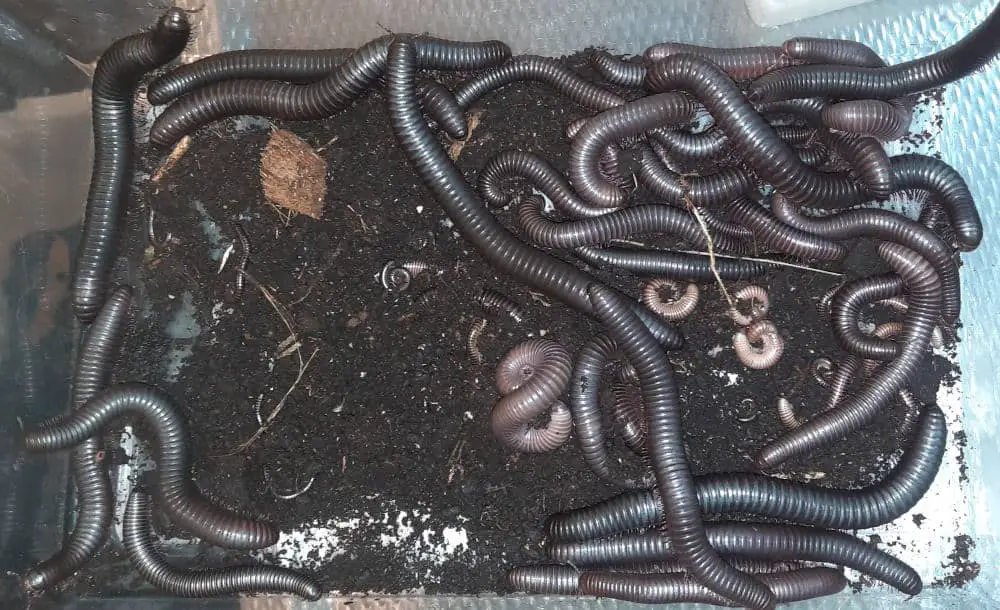
Breeding with your giant African millipedes
Breeding with your giant African millipedes needs a lot of patience. These millipedes grow slowly and it takes some time before they reach maturity. However, they are quite easy to breed. As long as you have a male and female (but even better) have multiple males and females, baby millipedes will eventually emerge from the substrate.
However, there are some things that can stimulate the breeding and success rate of offspring. We already mentioned a couple throughout this care guide. Below we list some key points to make better breeding success.
- The substrate should be of enough quality, contain a fine filler component (coconut fibre) and contain enough decaying organic matter (rotten wood, rotten leaves, flake soil).
- The substrate should have enough volume in total. It is recommended to have a substrate that is at least 15 cm or even 20 cm high (6″ to 8″). A shallow layer of substrate prevents females from laying eggs.
- The substrate should be kept damp at all times, but be careful that it is getting soaking wet. A substrate that is too dry will also prevent females to lay eggs, and even when eggs are laid will die off because of dehydration.
- Do not disturb the substrate. The less you dig or do anything with the substrate the higher the chance of successful breeding. So create enough nutritious substrate so that you can leave the substrate undisturbed for at least 1 to 2 years. If you worry if their is enough decaying matter in the substrate, add new rotten leaves on top of you substrate, but don’t dig it in.
Additional read
If you like to know more about the basics of keeping giant millipedes then read our basics guide for keeping millipedes.
Do you wonder how much it costs to keep millipedes? Not just how much it is to purchase a millipede, but all the costs you probably need to make for keeping millipedes. We have documented all the costs in this millipede initial and yearly cost breakdown.
Share this page!

